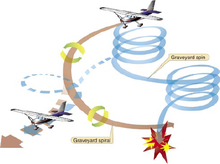- Graveyard spiral
-
In aviation, a graveyard spiral is a dangerous spiral dive entered into accidentally by a pilot who is not trained or not proficient in instrument flight when flying in instrument meteorological conditions (IMC). [1] Graveyard spirals are most common in nighttime or poor weather conditions where no horizon exists to provide visual correction for misleading inner-ear cues.[2] Graveyard spirals are the result of several sensory illusions in aviation which may occur in actual or simulated IMC, when the pilot loses awareness of the aircraft's attitude. In other words, the pilot loses the ability to judge the orientation of his aircraft due to the brain’s misperception of spatial cues. The pilot is unable to prevent the aircraft from entering a subtle banking movement of less than two degrees/second, leading to a gentle, banking “subthreshold spin.” [2]
- The graveyard spin consists of both physiological and physical components. Mechanical failure is often a result but generally not a causal factor, as it is the pilot’s sense of equilibrium which leads to the nearly inescapable spiral dive. Flying by “the seat of the pants,” and failing to recognize and/or respond to instrument readings is the most common source of what is referred to, in U.S. Air Force parlance, as controlled flight into terrain, or abrupt, violent collision with the earth.[2]
Contents
Physiological Causes
The vestibular system of the inner ear controls the brain’s sense of equilibrium—balance, coordination and orientation of the body in space. [3]
- The three semicircular ducts in the inner ear are oriented at roughly right angles to one another and detect changes in angular acceleration. In the graveyard spiral, the lateral duct is stimulated by the initial, subconscious start of the subthreshold spin. If this slow spin lasts for longer than 20-25 seconds, the pilot will experience the sensation that the aircraft is no longer turning in that direction. When the pilot attempts to correct the aircraft’s orientation to a normal attitude, the sensors in the duct are still stimulated by the lag time between the rotation of the head and the movement of the fluid inside the lateral canal. [3]
- Upon returning to a normal orientation, the inertial lag in the sensors tells the pilot’s brain to respond to a perceived turn in the opposite direction. Thus the pilot “corrects” by attempting to counter this perception of a spin in the opposite direction but actually re-enters it by steering into the initial turn direction. If the pilot fails to recognize the illusion and level the wings, the airplane will continue turning and losing altitude until ground impact. [2]
Physics of the Graveyard Spin
- The impression given by the senses in that situation would be level flight, with a descent indicated on the altimeter and vertical speed indicator. This usually leads to the pilot "pulling up" or attempting to climb by pulling back on the control yoke. In a banking turn, however, the plane is at an angle and will be describing a large circle in the sky. Pulling back on the control yoke has the effect of tightening that circle and causing the plane to lose altitude at an increasing rate. An increasing component of the lift being generated by the wings is directed sideways by the bank angle. At that point the aircraft is describing a descending circle or spiral. In the ever-tightening, descending spiral the aircraft eventually exits the base of the clouds and/or impacts the ground.[1]
To avoid this situation, a student pilot or a pilot under instruction uses a view limiting device to learn instrument flying proficiency under the supervision of a flight instructor. Instrument-rated pilots also use view-limiting devices supervised by an instructor or a safety pilot to practice instrument flight and maintain instrument flying proficiency.[2]
References
- ^ a b {{http://www.faa.gov/library/manuals/aviation/pilot_handbook/media/PHAK%20-%20Chapter%2016.pdf}} Access date 2010-03-30
- ^ a b c d e Link text,http://www.militarynewbie.com/pubs/CNATRA%20P-204%20-%20Joint%20Aerospace%20Physiology%20Student%20Guide.pdf],Joint Aerospace Physiology Student Guide: Spatial Disorientation Naval Air Training Command. Joint Specialized Undergraduate Pilot Training. Retrieved 2011-11-18
- ^ a b [1],Fundamentals of Aerospace Medicine By Jeffrey R. Davis, Robert Johnson, Jan Stepanek; Lippincott Williams & Wilkins, 2008. Retrieved 2011-11-18.
See also
- John F. Kennedy, Jr. airplane crash
- Spiral dive
- Aircraft dynamic modes#Spiral dive
Categories:- Aviation risks
Wikimedia Foundation. 2010.

